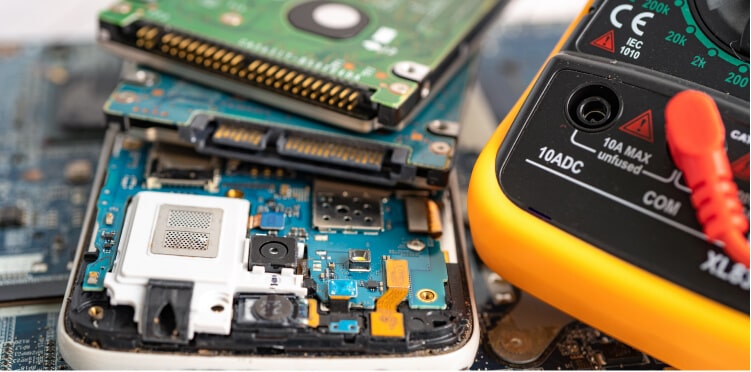Hyundai Motorstudio Senayan Park
Hyundai Motorstudio Senayan Park
Newsroom
-
What Is E Waste and How to Handle It?
- Hyundai Motorstudio Senayan Park 2022.08.09
-
Computers, laptops, tablets, and smartphones are a problem for the environment because when they reach their end of life cycle, they will become electronic waste, commonly called e waste.
For a rough calculation, 50 million tons of electronic waste are generated in one year, while the recycling rate cannot keep up. Reducing this number is useful for slowing climate change that is harmful to the environment.
Unlike other types of waste that can be recycled with simple tricks, even on a home scale, e-waste requires a complicated recycling process. That is why, unused electronic goods are more often found in the trash, instead of being recycled and reused.
What is E Waste?
E-waste refers to any product that uses electricity as a power source. Currently, electronic waste has 2-3% of the world's global waste. Although the portion seems small, its impact on health and the environment exceeds of all types of waste.
Only about 17% of e-waste that has been recycled. Electronic waste contains toxic materials such as beryllium, cadmium, and lead.
If the compound is exposed to strong radiation or rusts due to a chemical reaction, the toxic material is released into the atmosphere, seeps into the ground, and flows into nearby water sources.
This is the real reason why electronic waste should not be thrown away. If you have to, look for a community that collects used electronics because they know better how to handle it.
Handling electronic waste is not an easy task. In a circuit board, there are various electronic components such as resistors, transistors, inductors, and capacitors. It must be removed from the board one by one.
Electronic components that are still functioning are then stored for reuse, while hazardous materials are separated for different handling.
The majority of the components that are used on computers and smartphones are taken from non-renewable minerals. Recycling can prevent mineral supplies from being depleted until replacement materials can be found.
Although non-renewable material is not rare, recycling brings various advantages. A simple example, lithium is categorized as a non-renewable but easy-to-find material is now on the rise due to the adoption of electric cars. This vehicle requires a lot of lithium to store power in the battery.
How to Handle E Waste?
Reducing e-waste is beneficial for protecting natural resources and preserving energy. Recycling the metal components of older cell phones, instead of mining, can save energy that can be used to power 24,000 homes in one year.
The average household owns 24 electronic devices and currently 2.37 million tons of electronic products have become waste. That's enough to cover the five biggest football stadiums. There are not many ways to handle e-waste, but the following points can be your guide for managing e-waste.
- Re-evaluate: think for a moment whether the electronic product has reached the age limit and should be discarded, and is a new device really needed? As much as possible, choose a versatile and multifunctional device.
- Extend service life: for smartphones, complete them with a protective case to prevent damage and avoid charging for too long to avoid battery damage.
- Choose eco-friendly products: buy products that have an eco-friendly label marked with a triangular arrow, or an Energy Star, and are EPEAT certified.
- Donate: there are many communities that focus on e-waste, and this can be the best way to deal with e-waste on a household scale.
- Reuse: if a smartphone is damaged, not all components inside it are damaged, which might be reused. However, the process for reusing is not easy and requires in-depth knowledge of electronic components.
- Recycling: not every electronic device can be recycled and the problem is that the recycling process independently is difficult.
How is the E Waste Recycling Process?
Recycling of e-waste, in general, is more difficult than regular waste, and this should start with manual sorting. Once e-waste has been collected and taken to a recycling facility, it is sorted by type and model.
Each electronic device is examined to find out which components are still functioning then extracted. The non-functioning e-waste is then destroyed with special tools into small pieces.
Just before being completely destroyed, the waste first goes through a demanufacturing process. This process aims to separate the electronic components from circuit boards to remove hazardous materials.
The toner on a copier is prone for exploding and catching fire. It would be very dangerous because it could trigger an explosion that would damage the recycling facility. Once the trash is crushed, the metal and some high value materials will be separated.
Unlike in the early part of sorting, the separation is not done manually. Large magnets are placed to attract materials such as iron, steel, nickel, and others. While the material that is not bound to the magnet will be released when an electric current is induced.
At this stage, all the garbage left behind no longer contains magnets. The waste is then separated with water. Liquids make light materials like plastic float while heavy materials like glass sink.
The recycling process produces raw materials that can be sold to be used as raw materials to make other products.




